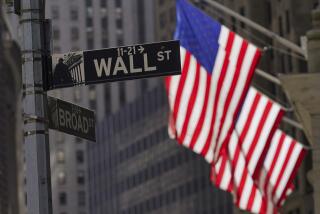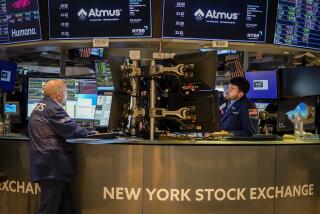Shapes of Things to Come
With the bull market in full gear the last three years, individual investors have become intimately acquainted with stock terms like “price-to-earnings ratio” and “book value.” Now that bonds have seized center stage--at least temporarily--it’s time to start talking like a fixed-income pro.
It’s easier than you think. In fact, if you know one simple concept, you’re well on your way. It’s called the yield curve, and it depicts the relationship between short-term and long-term Treasury bond rates.
There are two reasons investors should understand the yield curve.
First, it helps in deciding whether to buy short-term or long-term bonds in various economic and market conditions. Second, the direction of the yield curve has historically given valuable hints about where the economy is headed.
The yield curve is formed by plotting the interest rates paid by Treasuries of different maturities. The accompanying graph shows the yield curve--the yield for each of the major maturity periods.
Normally, long-term Treasuries pay higher rates than short-term issues, and for a very good reason. Long-term bonds are riskier because they require investors to tie up their money for longer periods. For those investors, there’s a greater chance that inflation--the sworn enemy of bonds--could perk up in that time.
When long bonds pay noticeably higher returns, the curve slopes upward or, in market lingo, steepens.
But there are times when the gap between long and short rates is narrow and the yield curve is flat. And in still rarer cases, when short rates are higher than long rates, the curve is said to be inverted.
Today, the yield curve is relatively flat, especially between six months and five years. And that holds important ramifications for investors, many of whom have suddenly have started taking a closer look at the merits of bonds.
On Sept. 30, before the Asian financial crisis had erupted fully, the difference between the rate on the three-month bill and the 10-year Treasury bond was exactly 1 percentage point. Today, that spread has narrowed to 0.34 percentage point.
In the past, flat or inverted yield curves have proved to be omens that the economy was slowing and headed for a recession.
At times when the economy has been strong, the Federal Reserve Board has frequently raised short-term rates to slow growth and stave off higher inflation. When the Fed has raised rates sharply, it has often helped trigger recessions.
When investors sense the Fed may be about to raise rates, they react by pushing up yields on short-term Treasuries. In such a scenario, long rates may remain steady while short rates rise, and the yield curve flattens or inverts.
The yield curve inverted briefly last week when three-year T-notes paid a higher rate than five-year notes. That reversed itself as the week ended. On Monday, there was another inversion, when the 5.14% rate on six-month T-bills eclipsed the 5.10% rate on the one-year.
A 1996 study by the New York Federal Reserve Bank showed that the yield curve does a good job of forecasting economic downturns a year in advance. As the spread between three-month and 10-year securities moves toward or into inversion, the chance of recession rises. For example, if the yield on the 10-year averages 1.21 percentage points above the three-month in a given quarter, there’s only a 5% chance of recession. When the curve has inverted and the three-month has averaged 2.4 percentage points more than the 10-year, there’s a 90% likelihood of a recession.
What’s notable lately is that the yield curve has flattened--although not for the usual reason.
Many economists expect the economy to weaken this year, in large part because of the problems in Asia. That’s created fears about broadly lower consumer prices or even an overall deflation. Investors have been dumping stocks and seeking safe haven in bonds.
Most observers think it’s unlikely the Fed will raise rates any time soon, so short-term Treasury yields aren’t moving up. Instead, long-term rates are falling because of the sudden demand to buy bonds and because inflation fears have receded. So the yield curve is flattening not because short rates are rising but because long rates are falling.
The crucial question for investors, then, is: What does this portend for the economy?
Most bond pros say it shows the economy will slow but not slip into recession. It also strongly suggests that the Fed’s next move on rates might be to cut them.
Late last week, short and intermediate rates fell faster than rates for longer-term securities. In fact, the rates on all Treasuries maturing in 10 years or less now trade below the 5.50% federal funds rate--a key sign the market expects a rate cut. (The federal funds rate is the standard rate for overnight loans between banks.)
Based on the model used in the yield-curve study, at the end of December there was only a 17% chance of a recession a year from now, said Arturo Estrella, the Fed economist who co-wrote the study.
So how might individual investors play the current situation?
Peter Van Dyke, a Treasury fund manager at mutual fund company T. Rowe Price, suggests sticking to intermediate Treasuries, between five and 10 years. That would put you in a good position to benefit if interest rates fall further. And if rates reverse course and head up again, you’d lose less than you would had you bought 30-year Treasuries.
“If something happens, that person would not be hurt as much,” Van Dyke said. “And if the curve does steepen because short rates come down, they’ll do very well for themselves being in the middle.”
Times staff writer Walter Hamilton can be reached by e-mail at walter.hamilton@latimes.com
(BEGIN TEXT OF INFOBOX / INFOGRAPHIC)
Riding the Curve
Normally, bond investors willing to tie up their money for longer periods are rewarded with higher interests rates. In a normal market, the “yield curve” rises steadily to the right. A flat or inverted curve is thought to be a sign the economy is headed for a slowdown. The curve below, reflecting market rates on Monday, runs almost flat up to terms of five years.
Inversion: A one-year Treasury bill now earns a lower interest rate than a six-month bill. The implication may be that bond investors think rates overall could continue to fall in the near future.
Source: Bloomberg News
California Municipal Bonds
T. Rowe Price & Associates tracks the yields of 20 California municipal bonds and the Bond Buyer Index of 40 national issues.
California Index: 4.96%
*
Bond Buyer 40-bond index
Friday: 5.13%
Five Widely Held California Bonds:
*--*
Issue Coupon Maturity Jan. 2* Calif. general-obligation 10-yr. (generic) (generic) 4.45% Calif. general-obligation 20-yr. (generic) (generic) 5.12 San Joaquin Toll 5.375% 1/15/29 5.22 Calif. public works lease rev. 6.00 10/1/14 4.85 San Fran. airport (insured) 5.65 5/1/24 5.16
Issue Friday* Calif. general-obligation 10-yr. 4.35% Calif. general-obligation 20-yr. 5.00 San Joaquin Toll 5.03 Calif. public works lease rev. 4.65 San Fran. airport (insured) 4.98
*--*
* Yield
Source: T. Rowe Price & Associates in Baltimore, which manages a $150-million California bond fund
Note: All yields are as of 2 p.m. Friday. Yields are based on institutional trading, retail prices and a survey of California brokers. Yields offered to individual investors will vary.
More to Read
Inside the business of entertainment
The Wide Shot brings you news, analysis and insights on everything from streaming wars to production — and what it all means for the future.
You may occasionally receive promotional content from the Los Angeles Times.










